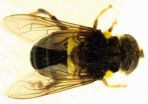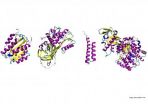(Press-News.org) AMHERST, Mass. – Just-forming stars, like growing babies, are always hungry and must "feed" on huge amounts of gas and dust from dense envelopes surrounding them at birth. Now a team of astronomers including Robert Gutermuth, a University of Massachusetts Amherst expert in imaging data from the Spitzer Space Telescope, reports observing an unusual "baby" star that periodically emits infrared light bursts, suggesting it may be twins, that is, a binary star. The discovery is reported this month in Nature.
The extremely young object, dubbed LRLL 54361, is about 100,000 years old and is located about 950 light years away toward the Perseus constellation. Years of monitoring its infrared with the Spitzer instrument reveal that it becomes 10 times brighter every 25.34 days, Gutermuth and colleagues say. This periodicity suggests that a companion to the central forming star is likely inhibiting the infall of gas and dust until its closest orbital approach, when matter eventually comes crashing down onto the protostellar "twins."
Gutermuth, who surveys star-forming molecular clouds with Spitzer to search for protostars, says, "The idea that this object is a baby binary system fits our data, so, twins fit our data. In single protostars, we would still see matter dumping onto the star non-uniformly, but never with the regularity or intensity of the bursts we observe in LRLL 54361. The 25.43-day period is consistent with the orbital period we would expect from a very close binary star."
The protostar twins, embedded in a gas "cocoon" many times larger than our solar system, offer an unusual chance to study what looks like a developing binary star system, he adds. Because dense envelopes of gas and dust surround embryonic stars, the only detectable light to escape is at longer, infrared wavelengths. "Spitzer's infrared camera is perfect for penetrating this cool dust to detect emission from the warm center," says Gutermuth.
"When you have two young stars feeding from the same circumstellar disk, the gravitational influence of the secondary companion can cause hiccups, an inhibition of infalling material from the disk. But when the orbital paths approach closely, that material can rush in, triggering feeding pulses for both stars and releasing a bright burst of light. The flash moves out from the center, reflecting off the disk and cavities in the envelope like an echo reverberating out from cave walls. We've seen the light flashes with Spitzer and have imaged the echo-tracing cavities in its envelope with the Hubble Space Telescope."
The light echo to which Gutermuth refers is seen in images taken at the near-infrared limit of the Hubble's Wide Field Camera 3 instrument. The lead investigator for this work and the Spitzer study is UMass Amherst alumnus James Muzerolle, now of the Space Telescope Science Institute, Baltimore. The investigators are careful to point out that they're not sure what is at the center of object LRLL 54361, but if it is an embryonic binary star, the prospects are exciting.
Scientists have shown that close binary low mass stars are a somewhat rare outcome of the star formation process. But understanding their formation is critical to address some of the fundamental open questions in star and planet formation, such as how protostars form, how they accumulate their mass and how planets form from their circumstellar disks, Gutermuth points out. It's believed that most of a central star's mass is assembled early, whereas planet formation in spinning outer gaseous disks may take several million years to complete.
Another reason this object is so interesting, he says, is that it provides a new demonstration of the impact of time-domain astronomy. "By analyzing the variability of this object's light over time, we have obtained a unique set of constraints on its physical nature. This system offers us a rare chance to observe the evolution of the disk and envelope around a binary star in almost real time."
"Looking ahead, we'll characterize this system further at millimeter wavelengths with the aid of the Large Millimeter Telescope now becoming operational under a partnership between UMass Amherst and Mexico's Instituto Nacional de Astrofísica, Óptica y Electrónica. Studying millimeter variability over time will be part of our approach."
INFORMATION:
International team observe 'hungry twin' stars gobbling their first meals
A team of astronomers including Robert Gutermuth at the University of Massachusetts Amherst, reports observing an unusual 'baby' star that periodically emits infrared light bursts, suggesting it may be twins, that is, a binary star
2013-01-31
ELSE PRESS RELEASES FROM THIS DATE:
Novel materials shake ship scum
2013-01-31
DURHAM, N.C. – Just as horses shake off pesky flies by twitching their skin, ships may soon be able to shed the unwanted accumulation of bacteria and other marine growth with the flick of a switch.
Duke University engineers have developed a material that can be applied like paint to the hull of a ship and will literally be able to dislodge bacteria, keeping it from accumulating on the ship's surface. This buildup on ships increases drag and reduces the energy efficiency of the vessel, as well as blocking or clogging undersea sensors.
The material works by physically ...
Biologistics: How fast do chemical trains move in living cells?
2013-01-31
The rate of chemical processes in cells is dictated by the speed of movement (diffusion) of molecules needed for a given reaction. Using a versatile method developed at the Institute of Physical Chemistry of the Polish Academy of Sciences in Warsaw, researchers were able to predict for the first time the diffusion coefficients of all proteins in Escherichia coli. The achievement is important not only for biologists and chemists, but also for... transport companies.
Understanding of chemical foundations of life requires knowledge about the rate of chemical reactions in ...
24 new species of flower fly have been found in Central and Southern America
2013-01-31
A team of scientists have described twenty four new species of dipterans belonging to Quichuana genus, of which only a further 24 species were known. The researchers, including two Spanish biologists, have been studying the forests of Central and Southern America for ten years and they have now published their results in the 'Zoological Journal of the Linnean Society'.
A ten-year study in forests of the American continent has resulted in the description of 24 new insect species from the Quichuana genus that are also known as 'flower flies'.
Up until now only a further ...
Rehabilitation therapies can lead to recovery from chronic fatigue syndrome
2013-01-31
Research led by Queen Mary, University of London, has shown that recovery from chronic fatigue syndrome (CFS) is possible for some patients, and has identified two treatments most likely to lead to recovery.
The latest results from the PACE trial* show that cognitive behaviour therapy (CBT) and graded exercise therapy (GET), as supplements to specialist medical care, increase the likelihood of recovery from CFS three-fold compared to other treatments studied. The trial, carried out in collaboration with researchers from King's College London, the University of Oxford ...
The humble 'virtual chimney' fences that could reduce the impact of airport pollution
2013-01-31
Simple 'blast' fences called baffles could deliver improvements in air quality for people living near airports, new research has found.
Placed behind a runway, the baffles could serve as a 'virtual chimney', funnelling emissions from aircraft engines upwards where they can disperse more effectively, thereby reducing the environmental impact on people living nearby.
Prototype baffles have been tested by a team of researchers from Manchester Metropolitan University, Cranfield University, University of Southampton and the University of Cambridge, with funding from the ...
Disulfiram: New support for an old addiction drug
2013-01-31
Philadelphia, PA, January 31, 2013 – Disulfiram was the first medication approved for the treatment of alcoholism over 50 years ago. It works, at least in part, by preventing the metabolism of an alcohol by-product, acetaldehyde. High levels of acetaldehyde in the body quickly cause unpleasant symptoms, including nausea, vomiting, headache, and accelerated heart rate. Thus, disulfiram provides a very strong incentive to avoid drinking.
Beginning in the late 1990s, a series of studies conducted at Yale University found that disulfiram reduced the consumption of cocaine, ...
Protein origami: Quick folders are the best
2013-01-31
Proteins are elementary building blocks of life. They often perform vital functions. In order to become active, proteins have to fold into three-dimensional structures. Misfolding of proteins leads to diseases such as Alzheimer's or Creutzfeld-Jakob. So which strategies did nature develop over the course of evolution to improve protein folding?
To examine this question, the chemist Dr. Frauke Gräter (Heidelberg Institute for Theoretical Studies) looked far back into the history of the Earth. Together with her colleague Prof. Gustavo Caetano-Anolles at the University of ...
A possible answer for protection against chemical/biological agents, fuel leaks, and coffee stains
2013-01-31
A recent discovery funded by the Air Force Office of Scientific Research (AFOSR) may very well lead to a process that not only benefits every uniformed service member of the Department of Defense, but everyone else as well: protection from Chemical/Biological agents, to self-cleaning apparel, to effortless thermal management, to fuel purification as well as enhanced control of leaks—especially oil and fuels.
In 2006, AFOSR Program Manager Dr. Charles Lee funded Professor Gareth McKinley at the Massachusetts Institute of Technology exploring nanocomposite technology ...
Second-generation CT scanner substantially reduces radiation exposure
2013-01-31
OAK BROOK, Ill. (January 31, 2013) – Researchers using a newly approved advanced computed tomography (CT) system were able to significantly reduce radiation exposure in patients undergoing coronary CT angiography (CCTA), according to a new study published online in the journal Radiology.
"Radiation exposure during diagnostic imaging is a substantial public concern," said Marcus Y. Chen, M.D., lead author of the study from the advanced cardiovascular imaging laboratory at the National Institutes of Health in Bethesda, Md. "Minimizing radiation exposure while maintaining ...
Corn cobs eyed for bioenergy production
2013-01-31
This press release is available in Spanish.
Corn crop residues are often left on harvested fields to protect soil quality, but they could become an important raw material in cellulosic ethanol production. U.S. Department of Agriculture (USDA) research indicates that soil quality would not decline if post-harvest corn cob residues were removed from fields.
This work, led by Agricultural Research Service (ARS) soil scientist Brian Wienhold, supports the USDA priority of developing new sources of bioenergy. ARS is USDA's chief intramural scientific research agency.
Wienhold ...
LAST 30 PRESS RELEASES:
UF dives deep into predicting storm damage with computer models
A stormy ocean voyage yields insights on the global carbon cycle
Scientists identify first non-coding gene that controls cell size
Demonstration of altermagnetism in RuO₂ thin films -- A new magnetic material for the AI era
Penn researchers awarded $25M to conduct trial using smartphones to fight heart disease
PCORI awards funding for new patient-centered healthcare research
Exploring the origins of the universe: 145 low-noise amplifiers complete ALMA telescopes
Empress cicada wings help illuminate molecular structure
Using sound waves to detect helium
Time burden in patients with metastatic breast and ovarian cancer from clinic and home demands
Researchers discover bias in AI models that analyze pathology samples
Scientists ID potential way to prevent brain injuries from triggering Alzheimer's
MASTER 2nd Open Call: Execution period kick-off
Algae for health in food and pharma
Advanced microrobots driven by acoustic and magnetic fields for biomedical applications
Chicago health information leader recognized for raising CPR readiness and blood pressure awareness
The Intimate Animal, a new book from Kinsey Institute Executive Director Dr. Justin Garcia
When blue-collar workers lose union protection, they try self-employment
New video dataset to advance AI for health care
MEA-based graph deviation network for early autism syndrome signatures in human forebrain organoids
New modeling approach sheds light on rare gut disease
Study documents potentially hazardous flame retardants in firefighter gear
Can certain bacteria regulate aging of the immune system and its related alterations?
AI model helps diagnose often undetected heart disease from simple EKG
There are fewer online trolls than people think
Cell membrane fluctuations produce electricity
Jeonbuk National University study shows positive parenting can protect adolescents against self-harm
Surface-engineered ZnO nanocrystals to tackle perfluoroalkyl substance contamination
This new understanding of T cell receptors may improve cancer immunotherapies
A new fossil face sheds light on early migrations of ancient human ancestor
[Press-News.org] International team observe 'hungry twin' stars gobbling their first mealsA team of astronomers including Robert Gutermuth at the University of Massachusetts Amherst, reports observing an unusual 'baby' star that periodically emits infrared light bursts, suggesting it may be twins, that is, a binary star




